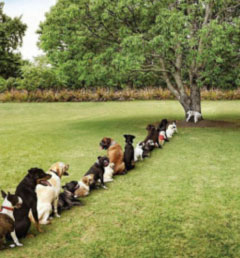
Vol. XIII, No. 2, February 2013
- Editor's corner
- Evidence that the staycation trend is both real & long-term
- Foundations Entertainment University - a 3-fer in March
- The bifurcated entertainment market; High Fidelity or die!
- A counterintuitive way to increase profits - scarcity
- 2012 North American cinema attendance increases
- Biases that can cause us to make bad decisions
A counterintuitive way to increase profits - scarcity
It is standard practice during the feasibility and design phase of developing a location-based entertainment (LBE) venue, which includes everything from amusement parks to FECs to bowling centers to laser tag centers, to size a project based upon it’s anticipated peak demand of attendance, what is called right sizing. The peak demand period that is used is called the design day. The design day is never the busiest day of the year. It doesn’t make economic sense to make the capital investment to size a center for the busiest day of the year any more than it makes sense to design a mall’s parking lot for the busiest shopping day of the year. The design day is often an average of a number of the busiest days or calculated at a percentile of attendance of all days of the year. The theory is that as a result of planning for the design day a center will be large enough to reasonably accommodate the large number of guests who come at peak attendance times, while at the same time not expending unnecessary capital to make the center larger than necessary. There will be a few times throughout the year when the center will be more crowded and queues longer than ideal.
 There is a limit to the waiting time in a queue at an LBE. There is a fine line of designing for scarcity
There is a limit to the waiting time in a queue at an LBE. There is a fine line of designing for scarcityThere is another counter-intuitive approach to sizing that can result in higher prices and revenues provided the project is high quality. It’s called scarcity. The idea is to limit capacity below the typical calculation for a design day. Think of the very popular restaurant where you have to make a reservation many days in advance to get a table or if you go on a weekend night, the wait might be long, such as at the Cheesecake Factory. Such restaurants are popular due to their high level of quality and service. Also, the scarcity, the difficulty in getting a reservation or the long wait allows them to maintain higher prices. The more popular a restaurant is, the more people want to go there and the more willing they are to pay a premium price. The popularity affirms the value.
There is a fine line to designing for scarcity for LBEs. You need to maintain a critical mass of attractions and experiences to assure it is a destination. You can’t make the LBE so small that it is over crowded all the time and queues are ridiculous. There is a limit to just what people will put up with to get something they perceive has high value. This is especially true today with consumers’ time-pressured lives.
The answer to how to best use scarcity for LBEs is exactly the way many restaurants do, take reservations. That means reservations for attractions such as laser tag, go-karts and bowling. What that does is remove the concern of visiting the LBE and not knowing how much time you will need to spend there. People’s lives today are experienced much like a television schedule, in fixed slots of time. They may only have a two-hour slot of time when they can visit the LBE on a Saturday. If they can make reservation and be confident that they will be able to ride the go-karts and play laser tag, then they are assured the experience will fit their schedule. If they think they might not be able to do it because of a wait, they probably won’t come.
A reservation system also adds to the perceived value of what people are willing to pay. For a large part of the LBE market, the higher socioeconomic consumers, their limited leisure time is often valued more than money. In other words, they will pay a premium to be able to maximize the use of their leisure time.
Scarcity and reservations is not currently part of the LBE design and operation paradigm. They are counter-intuitive, the opposite of what at first seems logical. Logic typically means that the highest profitability means serving the most people, when in fact, it means increasing demand by limiting supply. But it makes all the sense in the world when you really think about it.
Recommend reading:
Vol. XIII, No. 2, February 2013
- Editor's corner
- Evidence that the staycation trend is both real & long-term
- Foundations Entertainment University - a 3-fer in March
- The bifurcated entertainment market; High Fidelity or die!
- A counterintuitive way to increase profits - scarcity
- 2012 North American cinema attendance increases
- Biases that can cause us to make bad decisions


